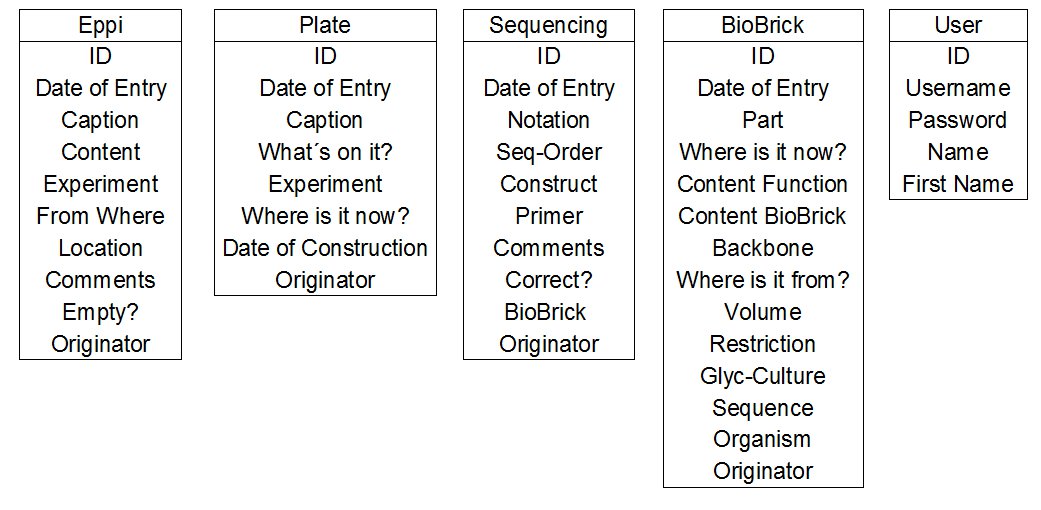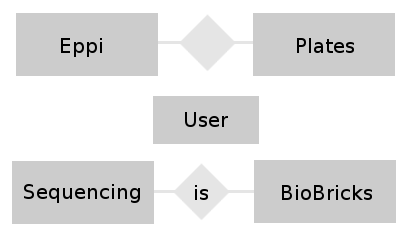Team:Bielefeld-Germany/Project/Database
From 2012.igem.org
(→Design of the database) |
|||
| Line 9: | Line 9: | ||
__TOC__ | __TOC__ | ||
| - | One important thing while working in such a bit group like ours is the organization of probes | + | One important thing while working in such a bit group like ours is the organization of probes. Therefore we designed our own database where we can make an entry for each probe we use. On this page you can find all information about this dadabase. |
=Design of the database = | =Design of the database = | ||
| - | *<strong> initial design </strong> : First of all we think | + | *<strong> initial design </strong> : First of all we think about the tables and the listings of the different tables we need. Here you can see our first abstract thoughts. This part of the design of a database is called the initial design of a database. |
| - | [[File:Bielefeld2012_Tabellen_Datenabnk.jpg|500px|thumb|left|Figure 1: The | + | [[File:Bielefeld2012_Tabellen_Datenabnk.jpg|500px|thumb|left|Figure 1: The initial design of the database.]] |
| - | We need the User table for the login. | + | We need the User table for the login and for the allocation of entries to the team members. In the User table we erect a ID specific for each team member. This ID can be used as a foreign key in the other tables. |
| - | + | Additionally we want to realize the following particularities: | |
| - | For the | + | * For the <strong>Plates table</strong> we want to write a script witch checks if the date of construction is older than two weeks. If the week is longer ago than these two weeks, the entry will bee marked in red automatically. So we have a easy way to check if all our plate are fresh. |
| - | + | ||
| - | + | ||
| - | + | * For the <strong>BioBricks table</strong> we want to name our BioBricks automatically. Therefore we write a script, witch assigned a BioBrick number, according to the affiliation to either eukaryotic, bacterial, fungal or others. | |
| - | *<strong> | + | * For the <strong> Eppis table</strong> it is very important, that you can always find out were a probe is. So we decides that we have to write a script witch controls if you insert a place of storage to you database entry, otherwise this entry couldn´t bee saved. |
| + | |||
| + | * One other very important point was, that the editing of entries is secured against mistakes, for example that one person make an entry and the other deleted it by mistake. Therefore we write a delete script witch deleted an entry not really. It saves the entry as a copy in the datebase but just shows ne newest copy of an entry. Witch this script t is possible to rebuild an entry if it is necessary. | ||
| + | |||
| + | * We did the same for the editing script. | ||
| + | |||
| + | |||
| + | *<strong> conceptual design</strong>: In this phase of the design we try to find relations between the different tables and build a entity-relationship-model. This model helps to visualize the entities (our different tables) together with their attributes (the entries belonging to a table) and the relationship between these entities. | ||
In the graphic below you can see our very easy E-R-Model. | In the graphic below you can see our very easy E-R-Model. | ||
Revision as of 19:10, 25 September 2012
Contents |
One important thing while working in such a bit group like ours is the organization of probes. Therefore we designed our own database where we can make an entry for each probe we use. On this page you can find all information about this dadabase.
Design of the database
- initial design : First of all we think about the tables and the listings of the different tables we need. Here you can see our first abstract thoughts. This part of the design of a database is called the initial design of a database.
We need the User table for the login and for the allocation of entries to the team members. In the User table we erect a ID specific for each team member. This ID can be used as a foreign key in the other tables.
Additionally we want to realize the following particularities:
- For the Plates table we want to write a script witch checks if the date of construction is older than two weeks. If the week is longer ago than these two weeks, the entry will bee marked in red automatically. So we have a easy way to check if all our plate are fresh.
- For the BioBricks table we want to name our BioBricks automatically. Therefore we write a script, witch assigned a BioBrick number, according to the affiliation to either eukaryotic, bacterial, fungal or others.
- For the Eppis table it is very important, that you can always find out were a probe is. So we decides that we have to write a script witch controls if you insert a place of storage to you database entry, otherwise this entry couldn´t bee saved.
- One other very important point was, that the editing of entries is secured against mistakes, for example that one person make an entry and the other deleted it by mistake. Therefore we write a delete script witch deleted an entry not really. It saves the entry as a copy in the datebase but just shows ne newest copy of an entry. Witch this script t is possible to rebuild an entry if it is necessary.
- We did the same for the editing script.
- conceptual design: In this phase of the design we try to find relations between the different tables and build a entity-relationship-model. This model helps to visualize the entities (our different tables) together with their attributes (the entries belonging to a table) and the relationship between these entities.
In the graphic below you can see our very easy E-R-Model.
- logically design : Creating the logically design for the database. For example for our table 'Eppi' we opt for the following logic:
| eppi ( | ID INT(11), |
| DataID INT(11), | |
| Caption TEXT, | |
| Content TEXT, | |
| Experiment VARCHAR(255), | |
| Where2 VARCHAR(255) , | |
| Location TEXT, | |
| Coments TEXT, | |
| Empty ENUM ('N', 'J'), | |
| Create_User INT(11), | |
| Creat_Date DATETIME, | |
| Edit_Date DATETIME, | |
| Delete ENUM ('N', 'J') | |
| Delete_User INT(11), | |
| Delete_Date DATETIME ) |
Programming the Database
Used Languages
For the programming language we used php. PHP is a general-purpose server-side scripting language and is originally designed for Web development to produce dynamic Web pages. It is one of the first developed server-side scripting languages to be embedded into an HTML source document and can also be used with many relational database management systems (RDBMS). As RDBMS and therefor for the construction of the tables in the database we used MySQL. MySQL is the world's most used open source RDBMS for the use in web applications. The SQL phrase stands for Structured Query Language. For the design of the tables and the look of them we use HTML. HTML stand for HyperText Markup Language and it is the main markup language for displaying web pages and other information that can be displayed in a web browser. So that we don´t have to design individually each table we use Cascading Style Sheets (CSS. This is a style sheet language used for describing the look and formatting of a document written in a markup language like HTML.
Important Functions
Here we listed some important functions we used.
Here you can see want we planed to edit I the next weeks.
| 55px | | | | | | | | | | |
 "
"







